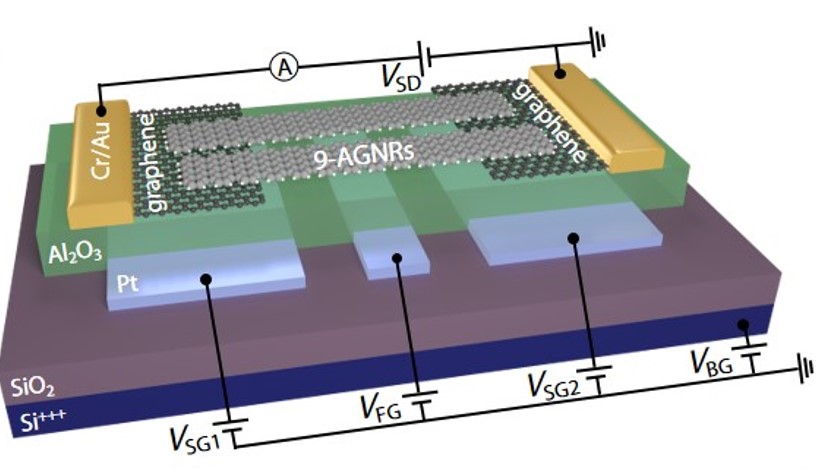Transport at Nanoscale Interfaces
Hybrid Nanoscale Interfaces
Device integration of graphene nanoribbons
Atomically precise, bottom-up-synthesized graphene nanoribbons (GNRs) have attracted strong interest from researchers worldwide as they constitute an emerging class of quantum designer materials, ideally suited for future electronic devices. Some of the major challenges towards their exploitation, however, is their reliable contacting due to their small size (<50 nm), as well as the preservation of their physical properties upon device integration.

Our recent experimental efforts in integrating GNRs in field-effect transistor devices use primarily graphene-based electrodes. Graphene, with its monoatomic thickness, allows the GNRs to be transferred on top of the electrodes, without introducing significant deformation and avoiding damage introduced by the deposition of metal electrodes.
The GNRs are synthesized and transferred onto the device substrate by the group of Prof. Roman Fasel at Empa. The GNR integrity and transfer quality is routinely investigated using polarization-dependent Raman spectroscopy. Here, we recently identified a longitudinal vibration mode in GNRs that allows extracting the length of the GNRs from the low-frequency Raman signature
Depending on the specific devices needs, we have developed several procedures to fabricate the nanogap, either using the electrical break down method or using a combination of electron-beam lithography and reactive-ion etching. In addition, we have implement different types of gates, with the most advanced ones being fingers as narrow as 10nm located directly below the GNR junction.
Besides electrical characterization, we also developed devices and measurement schemes for the thermoelectric characterization of GNRs for the extraction of the Seebeck coefficient and power factor.
In our pursuit for reliably contacting single GNRs, we also make use of carbon nanotube as electrode material.
Collaborators in Laboratory: Michael Stiefel, Wenhao Huang, Prof. Michel Calame
External partners: Prof. Roman Fasel (Empa), Dr. Pascal Ruffieux (Empa), Dr. Gabriela Borin-Barin (Empa), Rimah Darawish (Empa), Prof. Hatef Sadeghi (Warwick University), Prof. Vincent Meunier (Rensselaer Polytechnic Institute), Dr. Daniele Passerone (Empa), Prof. Herre van der Zant (TU Delft), Prof. Mathieu Luisier (ETH Zurich).
Funding: This project is partially funded by The EMPAPOSTDOCS-II programme. The EMPAPOSTDOCS-II programme has received funding from the European Union’s Horizon 2020 research and innovation programme under the Marie Skłodowska-Curie grant agreement number 754364. Additional funding is provided by the Swiss National Science Foundation (SNSF) under the Spark project no. 196795 and the FET open project QuIET (no. 767187).
References
- Overbeck, J. et al. A Universal Length-Dependent Vibrational Mode in Graphene Nanoribbons. ACS Nano 13, 13083–13091 (2019).
- Overbeck, J. et al. Optimized Substrates and Measurement Approaches for Raman Spectroscopy of Graphene Nanoribbons. Phys. Status Solidi Basic Res. 256, (2019).
- El Abbassi, M. et al. Controlled Quantum Dot Formation in Atomically Engineered Graphene Nanoribbon Field-Effect Transistors. ACS Nano 14, 5754–5762 (2020).
- Sun et al. Massive dirac fermion behavior in a low bandgap graphene nanoribbon near a topological phase boundary. Advanced materials 32, 12, p1906054 (2020)
- Braun et al. Optimized graphene electrodes for contacting graphene nanoribbons. Carbon 184, 30, p331-339 (2021).

Prof. Dr. Mickael Lucien Perrin
Group Leader Quantum Devices
Deputy Head of Laboratory
Phone: +41 58 765 4610